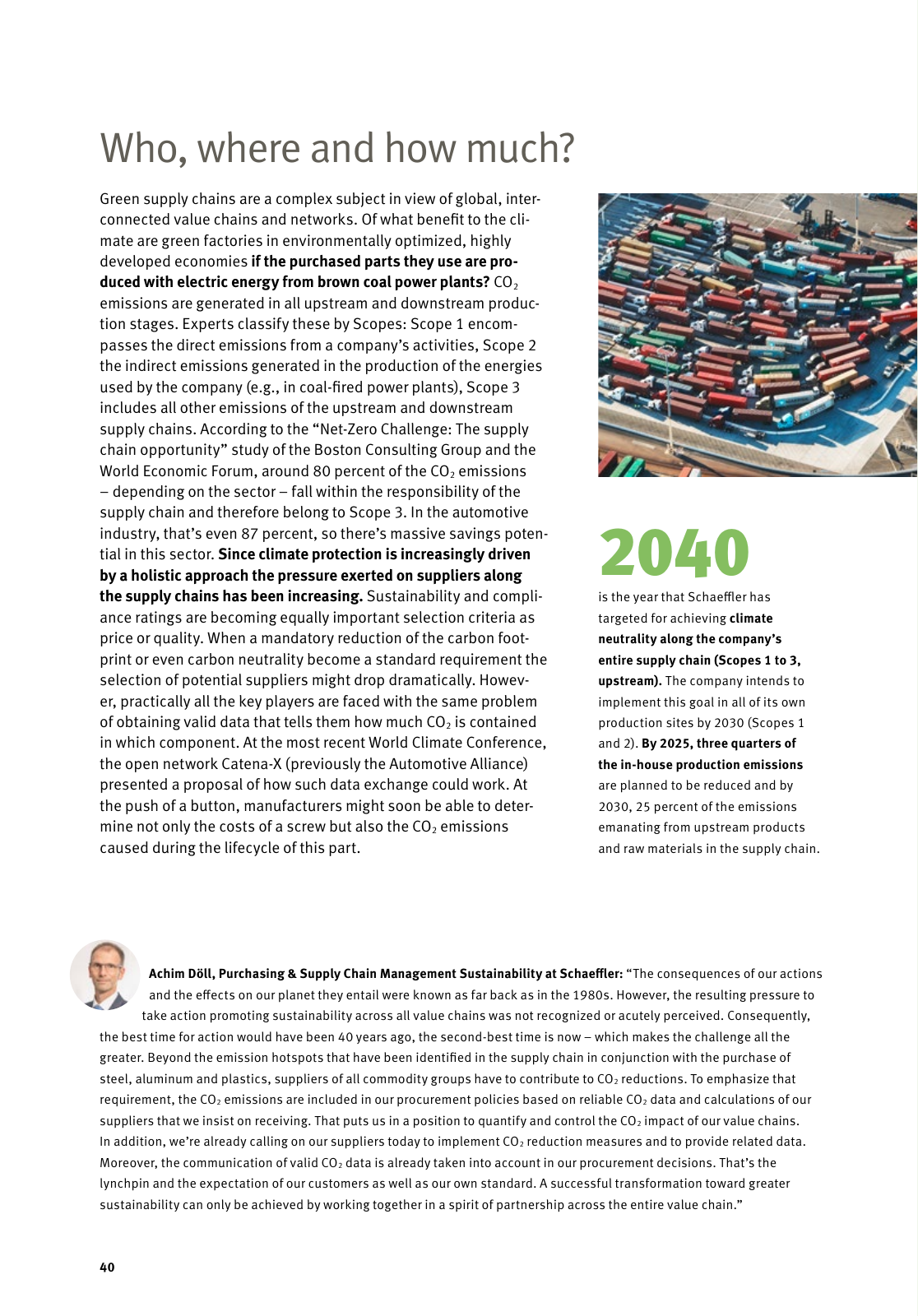is the year that Schaeffler has targeted for achieving climate neutrality along the company s entire supply chain Scopes 1 to 3 upstream The company intends to implement this goal in all of its own production sites by 2030 Scopes 1 and 2 By 2025 three quarters of the in house production emissions are planned to be reduced and by 2030 25 percent of the emissions emanating from upstream products and raw materials in the supply chain 2040 Green supply chains are a complex subject in view of global inter connected value chains and networks Of what benefit to the cli mate are green factories in environmentally optimized highly developed economies if the purchased parts they use are pro duced with electric energy from brown coal power plants CO2 emissions are generated in all upstream and downstream produc tion stages Experts classify these by Scopes Scope 1 encom passes the direct emissions from a company s activities Scope 2 the indirect emissions generated in the production of the energies used by the company e g in coal fired power plants Scope 3 includes all other emissions of the upstream and downstream supply chains According to the Net Zero Challenge The supply chain opportunity study of the Boston Consulting Group and the World Economic Forum around 80 percent of the CO2 emissions depending on the sector fall within the responsibility of the supply chain and therefore belong to Scope 3 In the automotive industry that s even 87 percent so there s massive savings poten tial in this sector Since climate protection is increasingly driven by a holistic approach the pressure exerted on suppliers along the supply chains has been increasing Sustainability and compli ance ratings are becoming equally important selection criteria as price or quality When a mandatory reduction of the carbon foot print or even carbon neutrality become a standard requirement the selection of potential suppliers might drop dramatically Howev er practically all the key players are faced with the same problem of obtaining valid data that tells them how much CO2 is contained in which component At the most recent World Climate Conference the open network Catena X previously the Automotive Alliance presented a proposal of how such data exchange could work At the push of a button manufacturers might soon be able to deter mine not only the costs of a screw but also the CO2 emissions caused during the lifecycle of this part Achim Döll Purchasing Supply Chain Management Sustainability at Schaeffler The consequences of our actions and the effects on our planet they entail were known as far back as in the 1980s However the resulting pressure to take action promoting sustainability across all value chains was not recognized or acutely perceived Consequently the best time for action would have been 40 years ago the second best time is now which makes the challenge all the greater Beyond the emission hotspots that have been identified in the supply chain in conjunction with the purchase of steel aluminum and plastics suppliers of all commodity groups have to contribute to CO2 reductions To emphasize that requirement the CO2 emissions are included in our procurement policies based on reliable CO2 data and calculations of our suppliers that we insist on receiving That puts us in a position to quantify and control the CO2 impact of our value chains In addition we re already calling on our suppliers today to implement CO2 reduction measures and to provide related data Moreover the communication of valid CO2 data is already taken into account in our procurement decisions That s the lynchpin and the expectation of our customers as well as our own standard A successful transformation toward greater sustainability can only be achieved by working together in a spirit of partnership across the entire value chain Who where and how much 40

Hinweis: Dies ist eine maschinenlesbare No-Flash Ansicht.
Klicken Sie hier um zur Online-Version zu gelangen.
Klicken Sie hier um zur Online-Version zu gelangen.